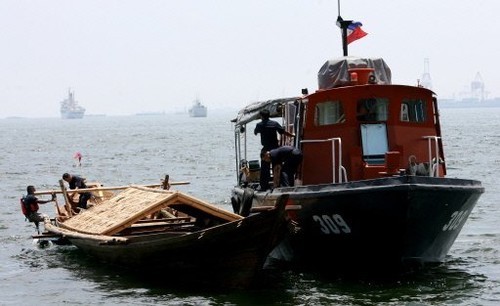Ancient Balangay sailing vessel sets out on four year saga
by Mindanao Examiner/Sail-World Cruising on 28 Jun 2009

Balangay being checked by coastguard - photo by Nat Garcia, AFP SW
A replica of an ancient Philippines boat, called a balangay, has finally been launched in Pasay City in Manila after many months of effort by a group of adventurers intent on showing the world the old mariner skills of the people of the Philippines.
The great dream began to unfold in a little corner of space near the grounds of the Cultural Centre of the Philippines . Led by Art Valdez, the man behind the success of putting Filipinos on the summit of Mt. Everest in 2006, the expedition will embark on a maritime adventure across the Philippine archipelago and beyond.
They will re-trace some of their ancestor’s journeys in the Indo-Pacific during pre-colonial times, and in the spirit of the long forgotten maritime heritage. It will be an ambitious four-year voyage which will carry them around Asia and on to Africa.
The craft is a copy of an ancient wooden boat excavated in the south in the 1970s, and carbon dated to 320 AD. It was apparently used by sea gypsies who once roamed Southeast Asian waters as well as the Pacific who also lived in the Philippines in ancient times, historians say.
The crew will navigate with methods used by ancient sailors without the benefit of modern GPS systems.
The vessel, christened 'Ngandahig', will visit every major port in the Philippine archipelago for the year, covering a distance of about 2,108 nautical miles.
It will then cross over to Sabah on the Malaysian part of Borneo from the southern Philippines and to Micronesia and Madagascar by next year. If the vessel survives the voyage, it is expected to return to Manila in 2013. (In previous http://www.sail-world.com/Cruising/Butuan-boat-ready-to-circumnavigate-the-world/57709!Sail-World_story the ambition was to circle the world - that has been now toned down a little)
The members of the Philippine Everest team - Leo Oracion, Erwin Emata, Noelle Wenceslao, Carina Dayondon, Janet Belarmino-Sardena, Dr Ted Esguerra, Fred Jamili and Dr Voltaire Velasco also comprise the core group of the Balangay expedition. The rest of the team will be composed of master sailors, academicians and scientists.
About the Balangay:
First excavated in the late 1970s in Butuan City, Agusan del Norte by the National Museum, a balangay (also called ‘Butuan boat’), is a plank boat adjoined by a carved-out planks edge through pins or dowels. Nine balangays were actually discovered: the first one was preserved and displayed in the excavation site, carbon-dated at year 320AD; the second was dated to 1250 and is now displayed in the National Museum; the third was moved to the Butuan Regional Museum for preservation works; the remaining six balangays remain in their original waterlogged condition, and are yet to be excavated.
Measuring 3 metres wide by 18 metres long, and drawing about a metre, the newly constructed balangay is made from a hardwood locally known as lupanga (or lutanga), an ubi-ubi family of apitong and dungon trees sourced from the eastern part of Tawi-Tawi.
It is believed that the balangay will float in 18 inches of water at zero load, a capability that will allow it to come close to shores or to sail in shallow waters.
About the construction:
A team of 10 Badjaos, also from Tawi-Tawi, led by Jubail Muyong from Sibutu and Haji Musa Malabong from Sitangkai built the boat from April to June, for a total of 41 days, with no drawn plans but based solely on knowledge passed from one generation to the next.
The boat builders were led by a professor at the Mindanao State University Jubail Muyong, who hails from the town of Sibutu and a retired school teacher, Hadji Musa Malabong from the island of Sitangkai. They constructed a 15 by 3-meter sized replica of the historic Balangay, a boat excavated in Agusan del Norte’s Butuan City in 1978.
Art Valdez initiated the idea of building the replica of the Balangay. Valdez and his team - the Kaya ng Pinoy Inc. - envision sailing the oceans using pre-colonial navigation by following the positions of the sun, the stars, and cloud formations, patterns of the waves, the directions of the wind and the migrations of birds.
During the construction of the Balangay, the team also considered the weather and the shape of the moon in their navigation, saying it will bring good luck and good voyage. The boat builders also used tools and materials that were made from wood.
Valdez first thought that not too many people knew what a Balangay was. So he decided to find people who could help him trace the story behind the Balangay and look for people who could execute and construct the boat basing from the original one.
Valdez’s determination led him to the islands of Sibutu and Sitangkai in Tawi-Tawi, where the ancient technique of building boats is still alive. The Badjaos, who played a big part in the ambitious sea adventure, used the same ancient building technique and method of construction as the Balangay of the 4th, 13th and 14th century A. D. - plank built, lashed lug, edge pegged and shell-first construction.
Valdez said the Badjaos’participation in the project will put things into its right perspective - shaping the image of the Badjaos as great shipbuilders with rich and colorful tradition and culture.
If you want to link to this article then please use this URL: www.sail-world.com/58368